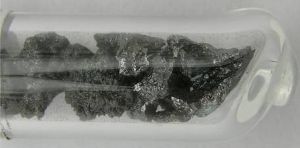The chemical element boron is classed as a metalloid. It was discovered in 1808 by Joseph L. Gay-Lussac and L. J. Thénard and independently by Sir Humphry Davy.

Data Zone
| Classification: | Boron is a metalloid |
| Color: | black |
| Atomic weight: | 10.81 |
| State: | solid |
| Melting point: | 2075 oC, 2348 K |
| Boiling point: | 3727 oC , 4000 K |
| Electrons: | 5 |
| Protons: | 5 |
| Neutrons in most abundant isotope: | 6 |
| Electron shells: | 2,3 |
| Electron configuration: | 1s2 2s2 2p1 |
| Density @ 20oC: | 2.34 g/cm3 |
Compounds, Radii, Conductivities
| Atomic volume: | 4.6 cm3/mol |
| Structure: | rhombohedral; B12 is icosahedral. |
| Hardness: | 9.3 mohs |
| Specific heat capacity | 1.02 J g-1 K-1 |
| Heat of fusion | 50.2 kJ mol-1 |
| Heat of atomization | 563 kJ mol-1 |
| Heat of vaporization | 480 kJ mol-1 |
| 1st ionization energy | 800.6 kJ mol-1 |
| 2nd ionization energy | 2427.1 kJ mol-1 |
| 3rd ionization energy | 3659.7 kJ mol-1 |
| Electron affinity | 26.7 kJ mol-1 |
| Minimum oxidation number | 0 |
| Min. common oxidation no. | 0 |
| Maximum oxidation number | 3 |
| Max. common oxidation no. | 3 |
| Electronegativity (Pauling Scale) | 2.04 |
| Polarizability volume | 3 Å3 |
| Reaction with air | mild, w/ht ⇒ B2O3 |
| Reaction with 15 M HNO3 | none |
| Reaction with 6 M HCl | none |
| Reaction with 6 M NaOH | none |
| Oxide(s) | B2O3 |
| Hydride(s) | B2H6 and many BxHy |
| Chloride(s) | BCl3 and many BxCly |
| Atomic radius | 85 pm |
| Ionic radius (1+ ion) | – |
| Ionic radius (2+ ion) | – |
| Ionic radius (3+ ion) | 41 pm |
| Ionic radius (1- ion) | – |
| Ionic radius (2- ion) | – |
| Ionic radius (3- ion) | – |
| Thermal conductivity | 27.4 W m-1 K-1 |
| Electrical conductivity | 5.0 x10-6 S m-1 |
| Freezing/Melting point: | 2075 oC, 2348 K |

Amorphous Boron in sample-tube. (Photo by Tomihahndorf)

Joseph Louis Gay-Lussac and Jean-Baptiste Biot collecting air samples at different altitudes. In addition to discovering boron, Gay-Lussac discovered that the composition of the atmosphere does not change with increasing altitude.
Discovery of Boron
Boron compounds such as borax (sodium tetraborate, Na2B4O7·10H2O) were known and used by ancient cultures for thousands of years. Borax’s name comes from the Arabic buraq, meaning “white.”
Boron was first partially isolated in 1808 by French chemists Joseph L. Gay-Lussac and L. J. Thénard and independently by Sir Humphry Davy in London. Gay-Lussac & Thénard reacted boric acid with magnesium or sodium to yield boron, a gray solid. (1) They believed it shared characteristics with sulfur and phosphorus and named it bore. (2)
Davy first tried to produce boron by electrolysis of boric acid, but was not satisfied with the results. He enjoyed greater success reacting boric acid with potassium in a hydrogen atmosphere. The result was a powdery substance.
Davy commented the substance was, “of the darkest shades of olive. It is opake, very friable, and its powder does not scratch glass.” After carrying out a number of chemical reactions to verify the uniqueness of the substance, Davy wrote, “there is strong reason to consider the boracic basis as metallic in nature, and I venture to propose for it the name of boracium.” (2)
Neither party had, in fact, produced pure boron. Their samples were only about 60% pure.
In 1909, American chemist Ezekiel Weintraub produced 99% pure boron, by reducing boron halides with hydrogen.
Almost a century later, in 2004, Jiuhua Chen and Vladimir L. Solozhenko produced a new form of boron, but were uncertain of its structure.
In 2009, a team led by Artem Oganov was able to demonstrate the new form of boron contains two structures, B12 icosohedra and B2 pairs. (3) Gamma-boron, as it has been called, is almost as hard as diamond and more heat-resistant than diamond.
Talking about boron’s part metal, part non-metal properties, Oganov said, “Boron is a truly schizophrenic element. It’s an element of complete frustration. It doesn’t know what it wants to do. The outcome is something horribly complicated.” (4)
Interesting Facts about Boron
- Boron is a tough element – very hard, and very resistant to heat. In its crystalline form it is the second hardest of all the elements on the mohs scale – only carbon (diamond) is harder. Only 11 elements have higher melting points than boron: these are C, W, Re, Os, Ta, Mo, Nb, Ir, Ru, Hf, and Tc. (As a challenge, how many of these elements can you name without looking them up?)
- Boron is an essential nutrient for all green plants.
- Boron in its crystalline form is very unreactive. Amorphous boron is reactive.
- Unusually, the universe’s atoms of boron were not made by nuclear fusion within stars and were not made in the big bang. They were made by nuclear fusion in cosmic-ray collisions. Most of the universe’s boron was made in this way before the formation of our solar system.
- Boron is an indispensable element in NIB magnets (Neodymium – Iron – Boron). NIB magnets are very powerful magnets invented in the early 1980s. They are used in computers, cell phones, medical equipment, toys, motors, wind turbines and audio systems.
- Boron is used to control nuclear reactions. It is an excellent neutron absorber. Alloyed with steel or reacted with carbon, titanium or zirconium, it is used in control rods for nuclear reactors.
- Pure boron can exist as a mixture of positive and negative boron ions.

Appearance and Characteristics
Harmful effects:
Elemental boron is not known to be toxic.
Characteristics:
Boron is a metalloid, intermediate between metals and non-metals. It exists in many polymorphs (different crystal lattice structures), some more metallic than others. Metallic boron is extremely hard and has a very high melting point.
Boron does not generally make ionic bonds, it forms stable covalent bonds.
Although opaque to visible light, boron can transmit portions of infrared light.
Boron is a poor room temperature conductor of electricity but its conductivity improves markedly at higher temperatures.
Uses of Boron
Boron is used to dope silicon and germanium semiconductors, modifying their electrical properties.
Boron oxide (B2O3) is used in glassmaking and ceramics.
Borax (Na2B4O7.10H2O) is used in making fiberglass, as a cleansing fluid, a water softener, insecticide, herbicide and disinfectant.
Boric acid (H3BO3) is used as a mild antiseptic and as a flame retardant.
Boron Nitride’s hardness is second only to diamond, but it has better thermal and chemical stability, hence boron nitride ceramics are used in high-temperature equipment.
Boron nitride nanotubes can have a similar structure to carbon nanotubes. BN nanotubes are more thermally and chemically stable than carbon nanotubes and, unlike carbon nanotubes, boron nitride nanotubes are electrical insulators.
Boron carbide (B4C) is used in tank armor and bullet proof vests.
Abundance and Isotopes
Abundance earth’s crust: 10 parts per million by weight, 1 part per million by moles
Abundance solar system: 2 parts per billion by weight, 0.2 parts per billion by moles
Cost, pure: $1114 per 100g
Cost, bulk: $500 per 100g
Source: Boron compounds are usually is found in sediments and sedimentary rock formations. The chief sources of boron are Na2B4O6(OH)2.3H2O – known as rasorite or kernite; borax ore (known as tincal); and with calcium in colemanite (CaB3O4(OH)4.H2O). Boron also occurs as orthoboric acid in some volcanic spring waters.
Isotopes: 11 whose half-lives are known, with mass numbers 7 to 17. Naturally occurring boron is a mixture of its two stable isotopes and they are found in the percentages shown: 10B (19.9%) and 11B (80.1%). 10B is used in nuclear reactors as a neutron-capturing substance.

References
- Alaa S. Abd-El-Aziz, Macromolecules Containing Metal and Metal-Like Elements Volume 8 Boron-Containing Polymers., (2007) p2. Wiley-Interscience
- Walter Channing, John Ware, New-England Journal of Medicine and Surgery, and Collateral Branches of Science., (1812) p220. T. B. Wait and Co. (pdf download 19.8 MB)
- Artem R. Oganov et al, Ionic high-pressure form of elemental boron., Nature 457, 863-867 (12 February 2009)
- Kenneth Chang, Theory and Experiment Meet, and a New Form of Boron Is Found., (February 2, 2009) New York Times Online
Cite this Page
For online linking, please copy and paste one of the following:
<a href="https://www.chemicool.com/elements/boron.html">Boron</a>
or
<a href="https://www.chemicool.com/elements/boron.html">Boron Element Facts</a>
To cite this page in an academic document, please use the following MLA compliant citation:
"Boron." Chemicool Periodic Table. Chemicool.com. 15 Oct. 2012. Web. <https://www.chemicool.com/elements/boron.html>.
Love the green flame thing
i know when a teacher gives you an assignment and its about the perodic table of elements this is the place you can go because its so easy
AWESOME!! totally cute! and reading was sooooooo easy! the green flame thing, just icing on the cake! thanks so much!! 🙂
guys i need help ASAP I’m having trouble finding boron’s weaknesses other than its poor conductivity at room temperature. i need some more from a project so, anything else you guys can help me with?
Thanks for your question Aidan. I’m not sure about weaknesses. You’re right about Boron’s electrical conductivity being low, but that could be a desireable property in situations where you need low conductivity.
hi where can you find boron